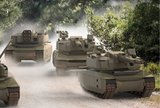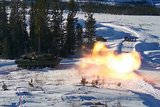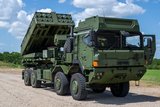Boeing begins delivering Brigade Combat Team Modernization capabilities to US Army
Boeing today announced that it began delivering Brigade Combat Team Modernization (BCTM) Increment 1 hardware to the US Army on Nov. 17, and made a second delivery on Nov. 22. The hardware included Network Integration Kit-equipped Mine Resistant Ambush Protected vehicles and Humvees, along with Unattended Ground Sensors and Unmanned Ground Vehicles.
These deliveries, which will continue through second quarter of 2011, are part of the low-rate initial production contract that Boeing received in February for the first brigade set of BCTM Increment 1 capabilities. The Army now will conduct additional verification testing prior to the capabilities' Initial Operational Test & Evaluation in 2011 and their subsequent deployment to Afghanistan in 2012.
"These deliveries are the culmination of many years of design and field testing to improve this system's reliability and usability for the nation's warfighters," said George Smith, Boeing BCTM Increment 1 Operations project manager. "We knew the schedule was going to be difficult, but this team excels at making the difficult happen."
BCTM Increment 1 capabilities will provide soldiers with enhanced intelligence, surveillance, and reconnaissance capabilities, as well as increased survivability and lethality. The capabilities will include:
- Network Integration Kit: an integrated computer system that hosts the latest communications and radio systems and battle command software, providing the initial network connectivity needed to transfer sensor and communication data.
- Small Unmanned Ground Vehicle: a robotic system capable of reconnaissance missions in dangerous or difficult situations such as entering buildings, caves and tunnels.
- Class I Unmanned Air Vehicle (UAV): a small, soldier-operated UAV that can hover for reconnaissance and surveillance while providing target acquisition.
- Unattended Ground Sensors: multi-mode surveillance sensors for target detection, location and classification, with an imaging capability for identification.
Source: Boeing
More from Land Warfare
-
![Rheinmetall and KNDS tank tie-up narrows trans-European options]()
Rheinmetall and KNDS tank tie-up narrows trans-European options
The French and German governments signed an agreement in June 2018 to cooperate on the development of a new main battle tank under the Main Ground Combat System programme but the effort has struggled. This new agreement may damage it further.
-
![2025 land market review: British Army woes, European heavy armour and US MBT progress]()
2025 land market review: British Army woes, European heavy armour and US MBT progress
The last year has seen several major procurements in the land market. Shephard’s Dr Peter Magill reviews the main trends and themes in land procurement of 2025.
-
![Hungary set to begin using Hero 400 loitering munitions]()
Hungary set to begin using Hero 400 loitering munitions
Developed by Israel's Uvision and with systems being sold in the thousands to multiple European NATO countries and the US, the Hero family of loitering systems is also in production in the US and Italy, the latter through Rheinmetall.
-
![Croatia orders Leopards and CAESAR howitzers as Lithuania orders more CAESARs]()
Croatia orders Leopards and CAESAR howitzers as Lithuania orders more CAESARs
The Leopard is becoming the tank of choice in central and eastern Europe as Croatia joins Lithuania, the Czech Republic and Hungary in ordering the platform. Lithuania and Croatia have also signed for CAESAR howitzers.
-
![Lockheed Martin to look further afield for GMARS rocket system opportunities]()
Lockheed Martin to look further afield for GMARS rocket system opportunities
The HX truck is already in use in many NATO and allied countries around the world as a logistics vehicle and carrier for high-value systems, including missile firing weapons, so its use for the Global Mobile Artillery Rocket System makes logistical sense.























